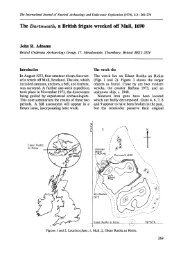port henderson : past & present - Royal Commission on the Ancient ...
port henderson : past & present - Royal Commission on the Ancient ...
port henderson : past & present - Royal Commission on the Ancient ...
Create successful ePaper yourself
Turn your PDF publications into a flip-book with our unique Google optimized e-Paper software.
this fishing industry, living in o<strong>the</strong>r villages in <strong>the</strong> Gairloch area).<br />
Dix<strong>on</strong> wrote that <strong>the</strong> cod fishing was carried <strong>on</strong> until about 1877 by means of l<strong>on</strong>g lines with<br />
baited hooks, <strong>the</strong> bait being mostly of mussels. Ga<strong>the</strong>ring and preparing of bait was traditi<strong>on</strong>ally <strong>the</strong><br />
work of women and children. The mussels had to be shelled by cracking <strong>the</strong>m open with a short bladed<br />
knife and <strong>the</strong>n <strong>the</strong> meat had to be scooped out. After 1877 nets mostly displaced <strong>the</strong> baited lines.<br />
Initially it had been felt that <strong>the</strong> use of nets would block off fish movement and <strong>the</strong> cod would move<br />
elsewhere. The lines were entirely made by <strong>the</strong> people <strong>the</strong>mselves, of horse-hair and hemp. Every<strong>on</strong>e<br />
in <strong>the</strong> area grew a small plot of hemp and <strong>the</strong> women spun flax in order to make <strong>the</strong> lines and nets. The<br />
hooks, fashi<strong>on</strong>ed from knitting needles, bent to <strong>the</strong> right shape and sharpened and barbed, were also<br />
home-made, for Gairloch used to be self-c<strong>on</strong>tained and <strong>the</strong>re was no need for any<strong>on</strong>e to go elsewhere<br />
to buy fishing equipment.<br />
Cod cost around three shillings in <strong>the</strong> 1930s. Although fishing improved after <strong>the</strong> first World<br />
War because stocks had a chance to replenish <strong>the</strong>mselves cod fishing ceased in <strong>the</strong> mid 1970s because<br />
of lack of fish.<br />
Lobsters and crabs<br />
Lobster fishing was of significance in <strong>the</strong> 1880s because catching <strong>the</strong>se crustaceans was a suitable<br />
occupati<strong>on</strong> for those men who were also crofters. Lobsters were caught close to <strong>the</strong> rocky coasts and<br />
small boats could be used. Lobsters were caught in baited creels which acted as a trap. Lobsters entered<br />
through <strong>the</strong> ‘eye’, a netted passage-way which was easier for ingress ra<strong>the</strong>r than for exit. Although<br />
<strong>the</strong>re were problems with trans<str<strong>on</strong>g>port</str<strong>on</strong>g>ing <strong>the</strong> catch from <strong>the</strong> West Coast of Scotland lobsters were an<br />
im<str<strong>on</strong>g>port</str<strong>on</strong>g>ant luxury item in large towns and cities, including as far away as L<strong>on</strong>d<strong>on</strong>.<br />
Crabs, as well as lobsters, were also caught although <strong>the</strong>re were few of <strong>the</strong>se. In Salt in <strong>the</strong> Blood<br />
by James Miller <strong>the</strong>re is a quotati<strong>on</strong> from Liz Duvill <strong>on</strong> page 93 who fished for crabs and lobsters with<br />
her fa<strong>the</strong>r, Alex Mackenzie, at Badachro in <strong>the</strong> mid 1950s. Then <strong>the</strong> price for crabs was poor and <strong>the</strong><br />
lobsters were sent to Billingsgate via Inverness. There was little local sale for lobsters except for <strong>the</strong><br />
hotels in <strong>the</strong> summertime. The Mackenzies had about 200 creels. Alex threw away any prawns which<br />
he caught (although later prawn fishing became <strong>the</strong> main catch for much of <strong>the</strong> Scottish fishing fleet).<br />
Fishing boats<br />
At <strong>the</strong> Gairloch Heritage Museum <strong>the</strong>re is <strong>the</strong> fishing boat, Ribhinn Bhoidheach or ‘Beautiful Maiden’,<br />
built at Port Henders<strong>on</strong> in 1914.<br />
This boat was built in <strong>the</strong> MacKenzies’ boat-yard <strong>on</strong> croft 12. The<br />
final bro<strong>the</strong>r c<strong>on</strong>tinued to build boats when he was over 90 years of age.<br />
(The MacKenzies who were recorded as boat carpenters lived in croft 15<br />
and rented croft 12). Ribhinn Bhoidheach was 14.8’ l<strong>on</strong>g with a breadth of<br />
The 'Beautiful Maiden'<br />
6.9’. She drew 3.0’ and had a registered t<strong>on</strong>nage of 1.75’. She was<br />
20



